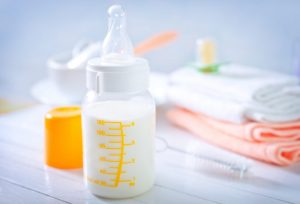You’ll need:
Bottles with teats andOur video is presented by Melissa Little, Paediatric Dietitian
Even when powdered infant formula is sealed, it can sometimes contain dangerous bacteria that could make your baby sick. Although these bacteria are rare, the infections they cause can be very dangerous.
To reduce the risk of infection, make up each feed as your baby needs it, using boiled water at a temperature of 70 degrees Celsius or above. Water at this temperature will kill any harmful bacteria that may be present. Remember to let the feed cool before you give it to your baby.
All equipment used to feed your baby needs to be sterilised. Bottles, teats and any other feeding equipment must be cleaned and sterilised before each feed to reduce the chances of your baby getting sickness and diarrhoea.
Use drinking water from the cold tap that has been freshly boiled (and cooled slightly to 70˚C or above) to make up a feed. Do not use water that has been previously boiled or artificially softened water. This is because the balance of minerals in previously boiled water and artificially softened water may not be suitable for making up formula feeds.
The water for your baby’s bottle needs to be hot when the powdered infant formula is added, to kill any harmful bacteria that may be present. Do not boil water in advance and store it in sterilised bottles in the fridge for later use. Bottled water is not recommended to make a feed.

Bottled water is not recommended to make up a feed as it is not sterile and may contain too much salt (sodium) or sulphate. If you have to use natural mineral water to make up a feed, check the label to make sure the sodium (also written as Na) level is less than 200 milligrams (mg) per litre, and the sulphate (also written as SO4) content is not higher than 250 milligrams (mg) per litre.
Like tap water, bottled water is not usually sterile, so if you have to use it you will still need to boil it before you prepare the feed.
A guide to making up a bottle of milk with powdered formula
Remember to let the feed cool before you give it to your baby. You can cool the bottle by holding it under cold running water or placing it in a bowl or sink which has cold water in it.
Feeding away from home
A convenient and safe choice is to use ready-to-feed infant formula milk with an empty sterilised feeding bottle if you need to feed your baby away from home.
However, if you are using powdered infant formula this is the safest way to make up a feed to take with you. You will need:
Make up a fresh feed in a bottle only when your baby needs it. The water must still be hot when you use it, otherwise, any bacteria in the infant formula may not be destroyed.
Remember to cool the feed before giving it to your baby by holding the bottom half of the bottle under cold running water. Move the bottle about under the tap to ensure even cooling. Make sure that the water does not touch the cap covering the teat.
The vacuum flask does not need to be sterilised but should be clean and only used for your baby. The boiling water should kill any bacteria present in the flask. If the flask is full and securely sealed, the water will stay above 70˚C for several hours.
Transporting a feed
If it is not possible to make up a fresh feed by following the advice above or if you need to transport a feed – for example to a nursery or childminder – you should prepare the feed at home and cool it, for at least one hour, at the back of the fridge.
Take it out of the fridge just before you leave and carry it in a cool bag with an ice pack – and use it within four hours.
If you do not have an ice pack or access to a fridge, the made-up infant formula must be used within two hours.
Warming a feed
Place the bottle in a container of warm water to heat it up. Always test the feed on the inside of your wrist to check it isn’t too hot before you give it to your baby.
Never use a microwave to heat infant formula as there is a danger of overheating the formula. It can also heat the milk unevenly (causing ‘hot spots’) and could scald your baby’s mouth.